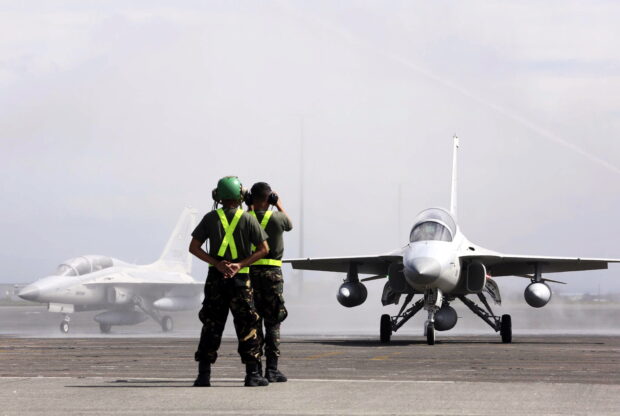
Two FA-50 PH Aircraft arrive at Haribon Hangar, Clark Air Base, Pampanga. (File photo by NIÑO JESUS ORBETA / Philippine Daily Inquirer)
MANILA, Philippines — As the selection of future fighter jets for the Philippine Air Force (PAF) remains up in the air, South Korea’s sole aircraft maker Korea Aerospace Industries (KAI) is offering what it believes is the “most cost-efficient” solution to boost the country’s air power capabilities.
The PAF’s multi-role fighter acquisition project has been a toss-up between the F-16 Viper of United States’ Lockheed Martin and Jas-39 Gripen of Sweden’s Saab, but the Philippines’ budgetary constraints have stalled a final deal.
KAI built the 12 FA-50 light fighters currently in use by the PAF, which were acquired under the Aquino administration for P18.9 billion to enhance the country’s territorial defense capabilities amid China’s increasing aggression in the West Philippine Sea.
Kim Sang-eung, KAI regional manager, said South Korea was proposing to export three squadrons or 36 additional FA-50s and a retrofit for the current light fighters to meet the PAF’s medium- and long-term goals to have a credible air defense and air power.
“FA-50 is the most cost-efficient solution that customers around the world opt to procure as next-generation multi-role fighter aircraft,” he said in a PAF pre-anniversary forum last week, without mentioning a price tag.
Janes, the global intelligence company specializing in military, aerospace and national security topics, reported last February KAI’s $920-million deal with Malaysia’s Ministry of Defense to supply an initial batch of 18 FA-50 light combat aircraft, giving each plane a price tag of $51.11 million (P2.8 billion at current exchange rates).
Various defense publications, meanwhile, list the price of the F-16 Viper at $64 million (P3.52 billion) and the Jas-39 at $85 million (P4.68 billion).
Marawi siege role
An upgrade of the current FA-50s used by the PAF would support air-to-ground, air-to-sea, and air-to-air mission objectives, Kim said.
The FA-50 light fighters were touted as “game changers” during the Marawi siege, a five-month battle between government troops and Islamic State-linked militants in 2017, which killed thousands.
Top security officials had said the conflict could have lasted longer without these assets providing air support for ground troops.
KAI is also pitching to export its indigenous KF-21 Boramae, a 4.5th generation warplane currently under development and expected to be in mass production starting in 2026.
Kim said the KF-21 is an “evolutionary next-generation fighter with affordability.”
The sales pitch to provide “affordable and capable” air assets was based on the PAF’s 2028 and 2040 strategic plans.
Major source
South Korea, one of the world’s biggest arms exporters, has been a major source of defense equipment for the Philippines. At the tail end of the Duterte administration, it signed new deals for six offshore patrol vessels and two corvettes for the Philippine Navy with a combined amount of P58 billion.
Lee Bong-keun, KAI vice president and general manager of the international business division, said in a visit to Manila last year that they have a “big plan” to sell more than 1,000 FA-50s in a decade.
Ironically, before the Korean War, the Philippines had stronger armed forces than South Korea, according to naval historian Mark Condeno.
But he said South Koreans apparently learned their lessons from the war and strived to be self-reliant for its defense needs.